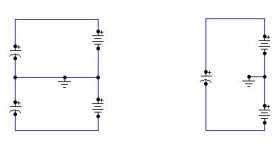What is the disadvantage associated with implementing the Filter Capacitor directly from rail to rail , excluding Center Tap which is usually Ground.......
This thought came into my mind while preparing to design a SMPS for Class-D amp........
Apart from High Voltage Rating of Capacitor, which is the other thing to be taken into consideration
This thought came into my mind while preparing to design a SMPS for Class-D amp........
Apart from High Voltage Rating of Capacitor, which is the other thing to be taken into consideration
Attachments
Hi
The disadvantage is that your ground impedance will be dictated by whatever the center tap is made of: batteries in your example, which may be aceptable. If you try the same trick with a transformer + diodes, you'll get some nasty surprises: during the blocking periods of the diodes, the center tap will be left floating, and therefore pretty useless for most applications.
LV
The disadvantage is that your ground impedance will be dictated by whatever the center tap is made of: batteries in your example, which may be aceptable. If you try the same trick with a transformer + diodes, you'll get some nasty surprises: during the blocking periods of the diodes, the center tap will be left floating, and therefore pretty useless for most applications.
LV
Nice Disadvantage!!!!!

 OK.........
OK.........
Elvee said:Hi
If you try the same trick with a transformer + diodes, you'll get some nasty surprises: during the blocking periods of the diodes, the center tap will be left floating, and therefore pretty useless for most applications.
LV

 OK.........
OK.........Workhorse said:What is the disadvantage associated with implementing the Filter Capacitor directly from rail to rail , excluding Center Tap which is usually Ground.......
Is this for a single ended or bridged output stage? High currents flow between the supply rails in a bridged design and between each rail and ground in a single ended design.
Re: Re: Filter Cap Directly from Rail to Rail, excluding Center Tap
Its for the Half Bridge Class-D amp....so i think Split capacitor is mandatory!!
BWRX said:
Is this for a single ended or bridged output stage? High currents flow between the supply rails in a bridged design and between each rail and ground in a single ended design.
Its for the Half Bridge Class-D amp....so i think Split capacitor is mandatory!!
I never understood the benefits of a rail-to-rail cap in an audio amplifier.
The positive and negative half waves are 180 out of phase, meaning each rail is loaded alternately.
What is that cap supposed to do?
The positive and negative half waves are 180 out of phase, meaning each rail is loaded alternately.
What is that cap supposed to do?
Workhorse said:What is the disadvantage associated with implementing the Filter Capacitor directly from rail to rail , excluding Center Tap which is usually Ground.......
This thought came into my mind while preparing to design a SMPS for Class-D amp........
Apart from High Voltage Rating of Capacitor, which is the other thing to be taken into consideration
i have done this on atx psu's that had half-bridge topology, whereas there were two 220ufd/200volt caps in series, i added a 470ufd/450 volt cap across and the power supply seemed to be able to deliver more evidenced by the pc's being overclocked, wheras before it could not.
😀
haven't tried it on an amp though...
- Status
- Not open for further replies.
- Home
- Amplifiers
- Power Supplies
- Filter Cap Directly from Rail to Rail, excluding Center Tap
